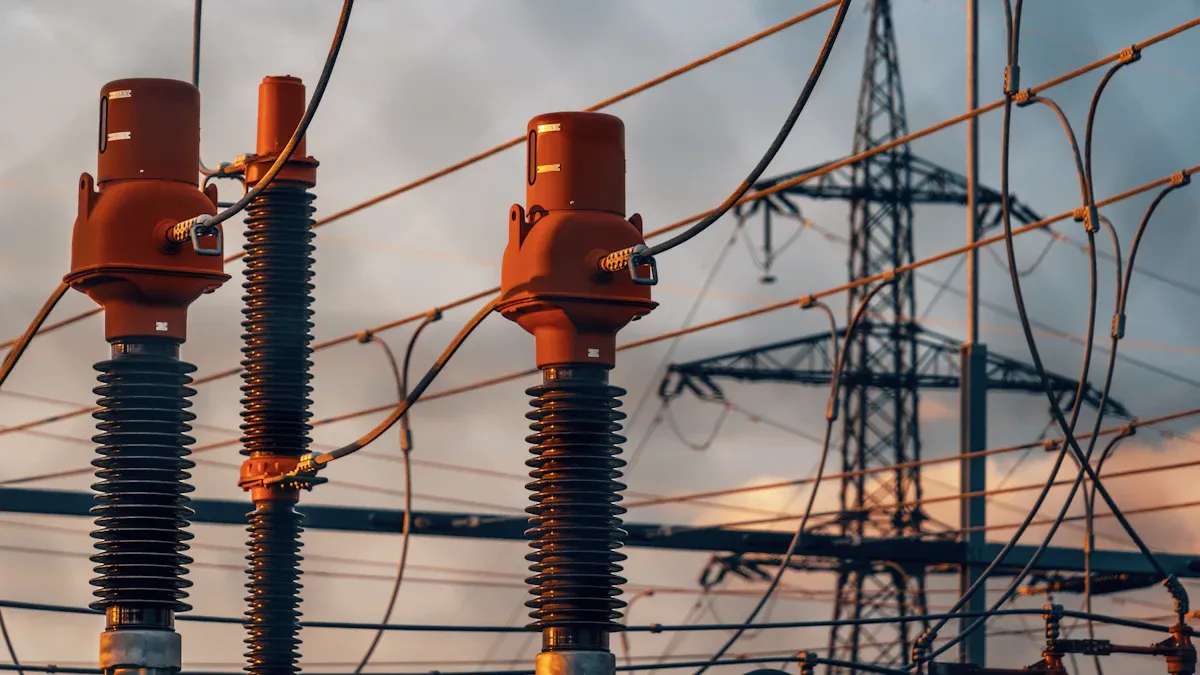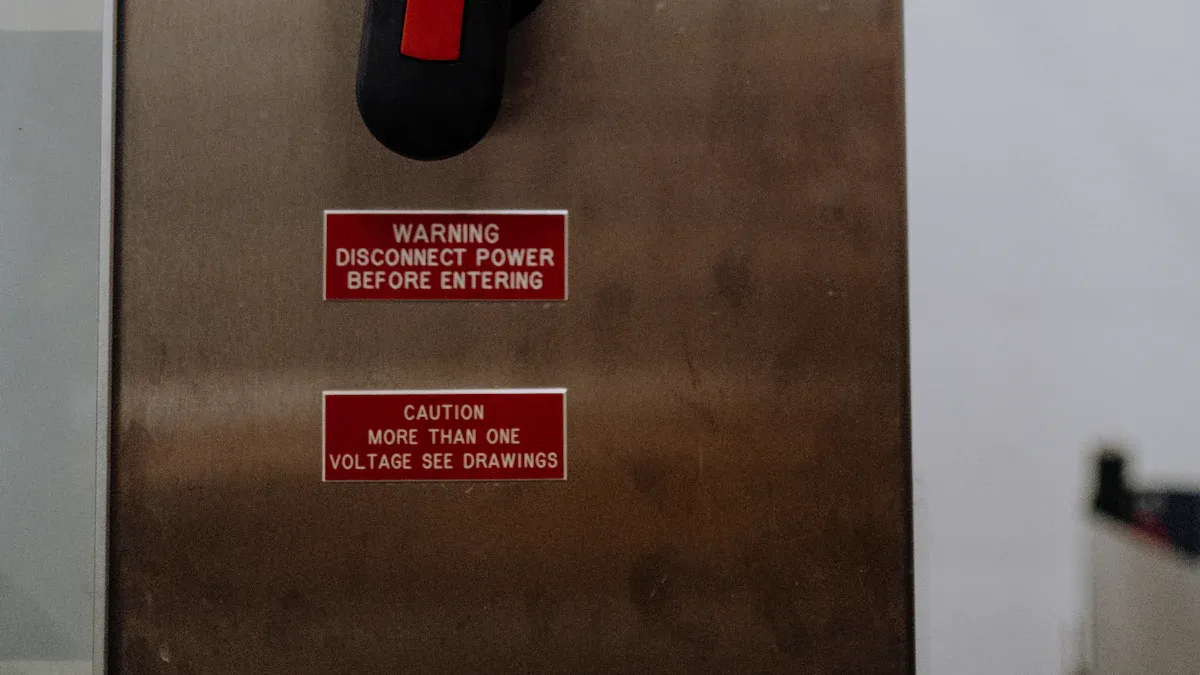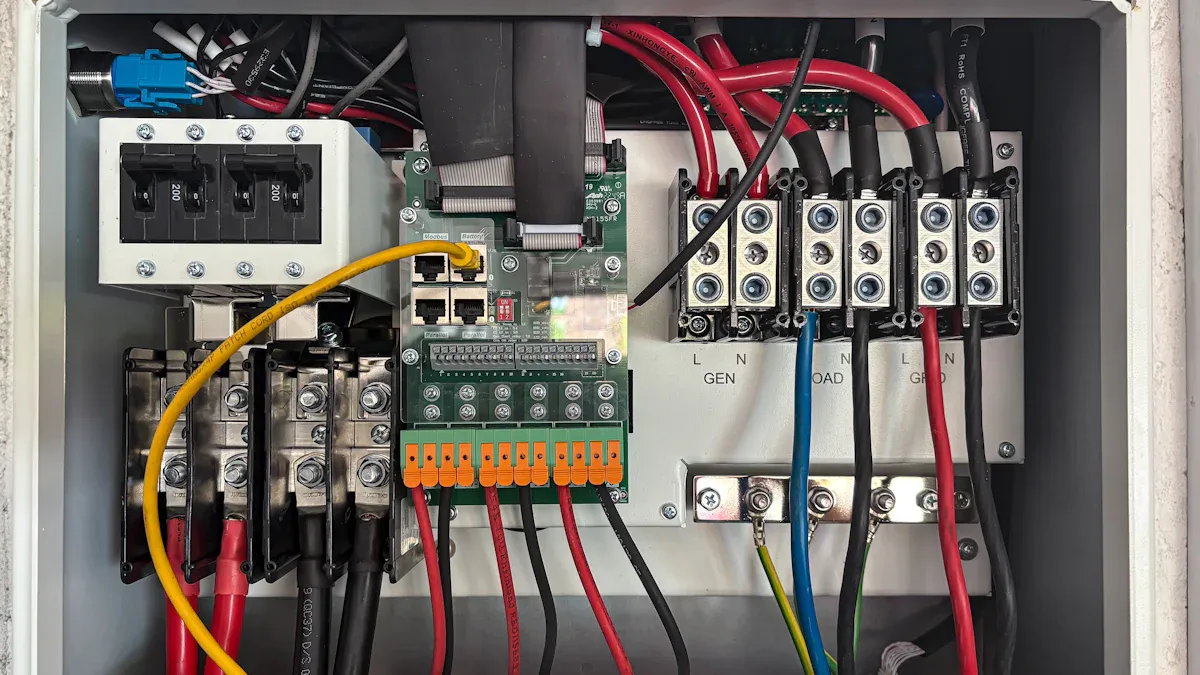Switchgear in 2025 Definition and Purpose for Electrical Safety

Switchgear is an important part of electrical systems today. It helps control and protect electrical equipment. It also keeps operations safe and smooth. Switchgear stops problems and manages electricity flow. This improves safety and efficiency. For example, the switchgear market for homes is growing fast. This is because people need more energy and safety rules are stricter. Governments and power companies now spend more on better switchgear. This helps update power grids and control electricity better. Switchgear is key for reliable power in homes, factories, and more.
Key Takeaways
Switchgear helps control and protect electrical systems for safety.
Keeping switchgear in good shape stops electrical accidents from happening.
Smart switchgear uses IoT to check systems and find problems fast.
It works with renewable energy to keep power steady and clean.
Pick low, medium, or high voltage switchgear based on your system's needs.
What Is Switchgear?

Definition of Electrical Switchgear
Switchgear is a group of tools that control electricity. It includes things like circuit breakers, fuses, and switches. These tools work together to manage electricity flow and stop problems. For example, circuit breakers shut off power during issues to prevent fires. Switchgear keeps power systems safe and working well in homes, factories, and power plants.
Think of switchgear as the brain of an electrical system. It decides where and when electricity should go. This makes it very important for keeping power systems reliable. There are different kinds of switchgear, like low-voltage and medium-voltage types. Medium-voltage switchgear can handle up to 75 kV and comes in designs like gas-insulated or air-insulated.
Importance of Switchgear in Electrical Power Systems
Switchgear is crucial for keeping power systems safe and steady. It controls electricity and protects the system from damage. Without it, power systems could break down, causing outages and dangers. For instance, when a problem happens, switchgear stops it from spreading to other areas.
Switchgear also helps use renewable energy like solar and wind. As we switch to cleaner energy, it manages these sources smoothly. It makes sure renewable energy flows into the grid without causing problems. This helps fight climate change.
Switchgear also saves energy by managing electricity carefully. It cuts down on waste and lowers costs. This is very useful in big factories or places that use a lot of power. With switchgear, your system works better, stays safe, and uses energy wisely.
Components of Electrical Switchgear
Circuit Breakers and Their Role
Circuit breakers are key parts of switchgear. They stop electricity flow when problems happen. This protects your system and prevents fires. For example, during a short circuit, the breaker detects it fast. It then cuts off power right away. This quick action keeps your equipment and you safe.
Circuit breakers also help keep systems running smoothly. They let you fix problem areas without shutting everything down. This way, other parts of your system keep working. Modern breakers handle many conditions, making them very reliable. But their performance can change with temperature or how often they’re used.
Disconnect Switches and Isolation
Disconnect switches are important for safety in switchgear. They let you safely cut power for repairs or maintenance. When working on a section, these switches stop electricity from reaching it. This lowers accident risks and keeps workers safe.
These switches are helpful in big systems with many parts. They let you work on one area without stopping the whole system. This avoids wasting time. Disconnect switches are simple tools that improve safety and efficiency.
Tip: Always check that disconnect switches are "off" before repairs.
Fuses, Relays, and Protection Mechanisms
Fuses and relays protect your electrical system. Fuses break the circuit if too much current flows. This stops overheating and damage. After a fuse blows, you must replace it to restore power.
Relays are more advanced than fuses. They find issues like overcurrent or voltage changes. Then, they send signals to other parts, like circuit breakers, to act. Together, fuses and relays protect your system from electrical problems.
How well these parts work depends on their design and conditions. For example, temperature changes can affect power converters in switchgear. Manufacturers give reliability info to help you plan and use your system better.
Busbars and Enclosures
Busbars and enclosures are key parts of switchgear. They help electricity move safely and efficiently. Knowing their roles shows how switchgear keeps systems reliable.
What Are Busbars?
Busbars are metal bars that carry electricity in switchgear. They send power to different circuits like a central hub. Copper or aluminum is used because they conduct electricity well.
Busbars come in shapes like flat strips or hollow tubes. Their size depends on how much electricity the system needs. For example, thicker busbars are used in high-voltage systems.
Did You Know? Busbars save energy by lowering resistance. This makes them better than regular wires.
Why Are Enclosures Important?
Enclosures protect switchgear parts, including busbars. They block dust, water, and accidental touches. This keeps the system and workers safe.
Enclosures are made of metal or strong plastic. The material depends on where the switchgear is used. Outdoor enclosures are weatherproof to handle tough conditions.
Key Benefits of Busbars and Enclosures
Safety: Enclosures stop accidental touches, preventing electric shocks.
Efficiency: Busbars make power flow better, improving performance.
Durability: Good enclosures protect switchgear, making it last longer.
Busbars and enclosures work together for safety and function. They are important for keeping electrical systems safe and running well.
Types of Switchgear
Switchgear comes in various types for different voltage levels. Knowing these types helps you pick the right one.
Low-Voltage Switchgear
Low-voltage switchgear works with voltages up to 1,000 volts. It is used in homes, offices, and small factories. It controls electricity and protects systems from problems like overloads.
Main parts include circuit breakers, fuses, and busbars. These parts work together to keep systems safe. For example, breakers stop power quickly during a problem. This prevents damage to your devices. Low-voltage switchgear is small and easy to set up, perfect for tight spaces.
Note: Check low-voltage switchgear often to keep it working well.
Medium-Voltage Switchgear
Medium-voltage switchgear handles 1,000 to 75,000 volts. It is found in big factories, power plants, and substations. It keeps electricity flowing smoothly and stops electrical issues.
This switchgear comes in designs like air-insulated, gas-insulated, or hybrid. Gas-insulated types use SF₆ gas, making them reliable and compact. They handle heavy loads while staying safe.
Tip: Pick medium-voltage switchgear with smart systems to find faults faster.
High-Voltage Switchgear
High-voltage switchgear works with voltages over 75,000 volts. It moves electricity over long distances, like from power plants to cities. It keeps big power grids stable and avoids blackouts.
It has strong parts like circuit breakers and disconnect switches. These are built to handle tough conditions and high power. You’ll see this switchgear outside, protected by weatherproof covers.
High-voltage systems need careful setup and expert care. They are vital for keeping power on for many people.
Did You Know? High-voltage switchgear helps add renewable energy to the grid.
Importance of Switchgear in Electrical Safety
Protection Against Electrical Faults
Electrical problems can harm equipment and be dangerous. Switchgear helps protect systems from these issues. It finds problems like short circuits or overloads and acts fast. For example, a circuit breaker in switchgear turns off power during a fault. This quick action stops fires and damage.
Switchgear also separates the faulty part of the system. This keeps the rest of the system working fine. By controlling the problem, it reduces downtime and repair costs. Its safety features protect both equipment and people nearby.
Tip: Check your switchgear often to ensure it works properly.
Ensuring Safe Maintenance and Repairs
Fixing and maintaining systems is important for smooth operation. Switchgear makes this safer by cutting power to certain areas. Disconnect switches let you turn off power to work safely. This prevents electrical shocks during repairs.
Switchgear also has clear signs and controls to show safe areas. These features lower the risk of accidents while fixing systems. In big setups, switchgear lets you work on one part without stopping everything. This saves time and keeps things running.
Note: Always make sure disconnect switches are off before repairs.
Contribution to System Reliability
Reliable systems are important for homes and businesses. Switchgear helps by keeping systems steady and avoiding failures. It watches electricity flow and adjusts it to stay stable. When problems happen, switchgear quickly isolates them to protect the system.
Switchgear also helps use renewable energy like solar and wind. It manages their changing power to keep electricity steady. This makes switchgear very useful in modern systems.
By improving reliability, switchgear lowers downtime and boosts productivity. Its safety and problem-solving features make it essential for safe and efficient systems.
Innovations and Future Trends in Switchgear

Smart Switchgear and IoT Integration
Smart switchgear is changing how we handle electricity systems. It uses IoT (Internet of Things) for real-time monitoring and control. You can check performance, find problems, and predict failures early. This helps avoid downtime and keeps systems safe.
For instance, IoT-enabled switchgear sends alerts to your phone or computer. If something goes wrong, you can act fast, even from far away. Smart systems also save energy by studying data and adjusting power use.
Tip: Upgrade to smart switchgear for better efficiency and lower costs.
Role in Smart Grids and Renewable Energy
Switchgear is key to improving modern power grids. Smart grids need advanced switchgear to control electricity flow. This keeps power steady, even during high demand times.
Solar and wind energy are not always steady. Switchgear helps add these sources to the grid by managing their changes. It ensures renewable energy works smoothly without causing issues. This makes using clean energy easier for everyone.
Did You Know? Switchgear stops blackouts by isolating problem areas in the grid.
Advances in Sustainable Switchgear Technology
Sustainability is now a big focus in switchgear design. Companies are using eco-friendly materials and cutting harmful gases like SF₆. These changes make electrical systems better for the environment.
You can also find smaller, energy-saving switchgear that reduces waste and saves space. These improvements help build greener and more efficient power systems.
Note: Picking sustainable switchgear helps the planet and saves money over time.
Applications of Switchgear Across Industries
Switchgear is crucial for safely managing electricity in many industries. It is used in power plants, factories, and even homes.
Power Generation and Distribution
Switchgear is vital for moving electricity from plants to users. High-voltage switchgear handles electricity over long distances. It stops problems from spreading and keeps the grid steady.
The need for high-voltage switchgear is rising. This is due to growing energy systems and more renewable energy use. For example, solar and wind power depend on switchgear to manage their changing output. New technology, like digital tools, makes these systems even more reliable.
Evidence Type | Description |
|---|---|
Market Growth | High-voltage switchgear market will grow 4.8% yearly from 2025 to 2033. |
Renewable Energy Integration | High-voltage switchgear manages changing electricity from renewable sources. |
Technological Advancements | Digital tools improve high-voltage system reliability and performance. |
Industrial and Manufacturing Facilities
Factories and industrial sites rely on switchgear for safety. It protects machines from overloads and short circuits, avoiding production delays. Medium-voltage switchgear is common here because it handles large power loads.
Switchgear also helps factories save energy. It reduces waste and cuts costs by managing power well. New rules aim to lower SF6 gas use, a harmful greenhouse gas in switchgear. Companies are working on safer, eco-friendly alternatives.
Rules now limit SF6 gas emissions from switchgear.
Safer insulating gases are being developed for sustainability.
Commercial and Residential Buildings
Switchgear is important in homes and businesses too. Low-voltage switchgear keeps electrical systems safe and reliable. It prevents problems like overloads that can harm devices or start fires.
In offices, switchgear manages complex power systems efficiently. At home, it offers a simple way to control electricity. Regular check-ups keep switchgear safe and working well.
Tip: Inspect your switchgear often to ensure safety and performance.
Switchgear is crucial for keeping electrical systems safe and reliable. It stops problems, controls energy flow, and helps use clean energy. New technology like IoT and AI makes switchgear smarter. These tools help find issues quickly and fix them faster. As people use more energy, modern switchgear manages it better. For example, China’s State Grid Corporation is spending CNY 473 billion on smart grids. This shows how important switchgear is becoming. By 2025, switchgear will improve even more, making electrical systems safer and greener.
FAQ
What is the main purpose of switchgear?
Switchgear controls and protects electrical systems. It stops problems, keeps things safe, and makes systems reliable. Think of it as the protector of your electrical setup, ensuring everything works well.
How does switchgear improve electrical safety?
Switchgear finds problems like short circuits or overloads fast. It stops these issues to avoid damage, fires, or accidents. It also lets you safely fix systems by turning off power in certain areas.
Can switchgear handle renewable energy sources?
Yes, modern switchgear works with solar and wind energy. It balances their changing power and connects them to the grid. This keeps electricity steady and reliable.
What are the types of switchgear available?
Switchgear comes in three types:
Low-voltage: Used in homes and small offices.
Medium-voltage: Found in factories and substations.
High-voltage: Used for power grids and long-distance electricity.
Why is smart switchgear important?
Smart switchgear uses IoT to monitor and control systems. It spots problems early, saves time, and boosts efficiency. You can get alerts on your devices to manage systems easily from anywhere.
Tip: Upgrade to smart switchgear for better energy use and performance.
See Also
Advantages of Automation in Modern Manufacturing Warehouses
Essential Cybersecurity Strategies for Intelligent Transport Systems
Get Prepared: Discovering New Transport Tech for Supply Chains
Prepare Yourself for the Transport Technology Revolution Ahead
Comprehensive Guide to Eco-Friendly Transport in Supply Chains
